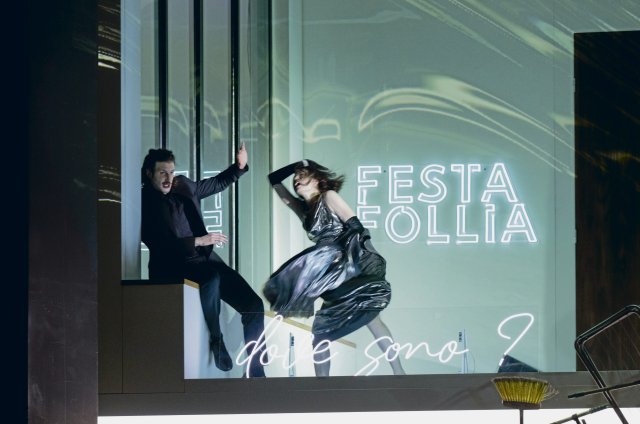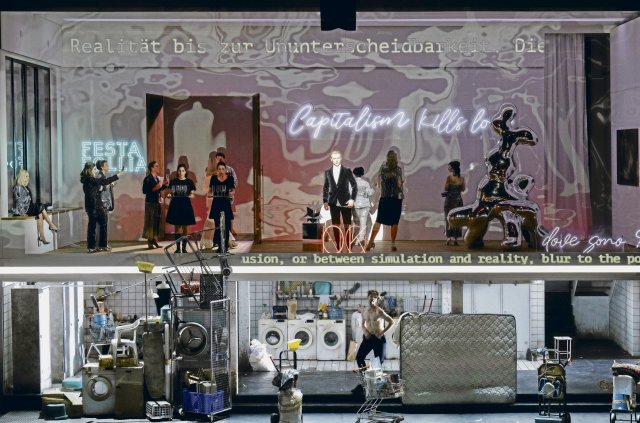A strong stage design shows both those up there and us down there.
Photo: Monika Rittershaus
Director’s theater versus “historical” performance, a hundred years after Otto Klemperer’s commitment to the director’s theater at the Berlin Kroll Opera, that still seems to be a topic that concerns opera fans – but more so the neocons among the reviewers than the audience.
In any case, Kirill Serebrennikov’s wild production of Mozart’s “Le Nozze di Figaro” at the Komische Oper Berlin has something to chew on for the advocates of historicizing centuries-old works, because the Russian director, who is also responsible for the stage and costume design, presents traditional and original works The opera conventions dear to the bourgeoisie are turned upside down, and one of their favorite stylistic devices really hurts the neocons: disenchantment!
It starts with the stage design. He works with a two-part stage: Above we see a feudal home of members of the upper class (for Mozart and his librettist Da Ponte a count’s palace, for Serebrennikov a rich man’s apartment of our time with cool modern representational art in the Jeff Koons kitsch style), in the basement, in The service staff live and work in the lower half of the stage. You up there, we down there.
Okay, this is not (yet) about class struggle, but rather about pressure and counter-pressure. Mozart’s opera is not a revolutionary piece like its original, namely Beaumarchais’ comedy, which was forbidden by Emperor Joseph II – Da Ponte deleted Figaro’s sharp political speech and denunciation of the ruling class from its fifth act and instead gave his Figaro a rather dull Chauvi aria about the alleged betrayal of all women. One of the weaker numbers in the opera. Incidentally, in his memoirs, Da Ponte boasts of having convinced the emperor of the political harmlessness of his libretto, so that nothing stood in the way of its premiere on May 1, 1786 in the Vienna Court Theater.
Serebrennikov makes two main changes: First, he puts Susanna at the center of the entire opera. For him, Susanna is “the one who really knows how to get out of all problems and stay several steps ahead of the situation,” he states in the program book. And it’s no coincidence that Susanna is on stage more than any of the other characters, and her musical material is more varied, even if she hardly sings a big aria, apart from “Deh vieni, non tardar” from the fourth act.
But Susanna is the powerhouse of this production, a pragmatic, intelligent and clever woman who is an important part of the general victory of women over men in this opera, and Penny Sofraniadou succeeds in interpreting this role as a calm but always combative modern woman unique in playing and singing.

Also a battle of the sexes: “Le Nozze di Figaro”
Photo: Monika Rittershaus
The big change, in addition to the display of class antagonism, is the doubling or splitting of the Cherubino into two figures. Of course, this trouser role is always a bit strange for a mezzo-soprano – Cherubino is “the sexual center of the opera, its pulse, which ensures emotional intensity and some scenes that boil over,” says the director. But how can this “irresistible sexual energy,” the epitome of Eros, be embodied by a woman who is forced to hide in a tight male suit and behind a mask of the opposite sex?
Serebrennikov solves this problem by making Cherubino a deaf-mute whose sign language is understood only by his “antithesis,” namely Cherubina. We experience Georgy Kudrenko as a dancer who can only express himself and his feelings physically (but how intensely he succeeds!), while Susan Zarrabi, who loves him, translates him to a certain extent and is also allowed to sing the wonderful canzone “Voi che sapete”. Mozart’s “mini-drama of the youth awakening in his sexuality between pleasure and suffering” (Ulrich Schreiber), the so light-looking Kavantina, into which Mozart repeatedly incorporated sophisticated and almost mysterious distortions.
Of course, through the doubling of Cherubino/Cherubina, the opera also loses some of its inherent, hidden queerness, which is characteristic of the young man who is actually a woman and loves women. But the prize is another couple model: young people who suffer from unrequited love but find each other over the course of the play. Dramaturgically, it all makes sense.
And the main characters, Count and Countess Almaviva? The Countess is the actual tragic figure of this opera, oppressively portrayed in her loneliness and desperation and sung by Nadja Mchantaf, between a death wish if her husband no longer shows his love for her (“Porgi, amor, qualche ristoro” – “Hear my plea” n, o God of love”), and memories of past hours of bliss in her second big aria (“Dove sono i bei momenti”).
Mozart has the Countess formulate man’s right to earthly happiness. The Count, on the other hand, is a very wealthy man who surrounds himself with flashy art and pursues all the women around him – an unpleasant, self-absorbed guy, as if painted for #MeToo, a mixture of Dominique Strauss-Kahn and Harvey Weinstein Here, however, he comes across as a kind of Goetzsche Johann Holtrop, at the same time totally uptight in his vain lust for power, but also powerful and unscrupulous (impressive, especially vocally: Hubert Zapiór). Serebrennikov has assigned him a canine security henchman who ultimately demonstrates his master’s absurd existence with all sorts of slapstick numbers – it’s a pleasure to watch Nikita Kukushkin.
How amusement comes more and more to the fore in this production. The mixed auxiliary troops, which the Count and Figaro each ensure, but also Susanna as a much more clever mastermind, allow the opera to move piece by piece “from individual comedy to class struggle” (Schreiber). We experience a “mixed order of battle,” which is also reflected in the quasi-equal distribution of numbers among arias (e.g. the Count) in the style of opera seria and opera buffa ensembles, i.e. in their upgrade compared to traditional operas. The production is simply fun, it is a wonderful pleasure to watch and listen – we experience “a great day”, as the opera is called in the subtitle, alluding to Beaumarchais.
nd.Kompakt – our daily newsletter
Our daily newsletter nd.Compact brings order to the news madness. Every day you will receive an overview of the most exciting stories from the world editorial staff. Get your free subscription here.
Mozart’s wonderful music contributes significantly to this pleasure, as does its interpretation by the Komische Oper’s chief conductor, James Gaffigan, and the enthusiastic orchestra. Gaffigan relies on the strong contrasts that Mozart composed, be it in the characterization of the characters, for example horn and string pizzicati to underline the machismo of the rather simple Figaro, or trumpets and timpani for the Count. Or he juxtaposes loud and quiet sound surfaces, as the breathless overture suggests.
In his “Aesthetics” of Mozart’s music, Hegel already praised the “dramatic concerting, like a kind of dialogue, where the character of one type of instrument indexes and prepares the character of the other, one gives the other a response or adds something “It is not permitted to pronounce it according to the sound of what has gone before.”
The finale of the second act is brilliant, this 20-minute tour de force through all timbres and tempos, in which the character of the music constantly changes. Mozart and Da Ponte act here as the inventors of a Hitchcock-like suspense trick: as viewers, we always know more than the actors. The Count suspects there is a rival in the Countess’s locked boudoir and has the door broken down – but to the surprise of the Count couple, Susanna comes out, who in the meantime has helped the naked Cherubino escape (with a mighty headlong dive out the window).
Mozart literally freezes time with a triple meter in the molto andante before accelerating the tempo again and building it up to a chain finale: Figaro appears, then the gardener, each one causes new confusion, and finally three more actors come into play with a contract The plot takes a turn for the absurd and Mozart accelerates again, allowing the second act to end in a wild prestissimo. The plot is just a ridiculous mess, but the dazzling music is more complex than the plot and without it Serebrennikov’s production would be lost.
One could talk for a long time about the many ideas and surprises of this production: how after the break the third act is introduced, literally out of the blue, with the wonderful terzettino “Soave sia il vento” from “Così fan tutte”, one of Mozart’s most beautiful opera pieces in general – and with its magical fallacious harmonies on the word “desir” that indicate a disorder; Something is wrong, not with the feelings of the two love-struck sisters in the “Così” and not with those of the “Figaro” staff who are scheming against each other. On the wall, a curved fluorescent tube proclaims: “capitalism kills love”!
The red sparkling hell scene and Serebrennikov’s hall of mirrors in the second part will also be remembered. Of course, not everything about this production is equally successful. Sometimes less would be more, the music says a lot that doesn’t have to be constantly duplicated by staged actionism. The fact that the servants have to laboriously change clothes in the lower stage during the overture is rather annoying, and the wedding dance towards the end, in which all the women are murdered, is simply nonsense. The displayed text messages with which the actors pass messages to each other, on the other hand, are quite funny, including all the typographical errors typical of SMS, and almost incidentally solve the dramaturgical problem of how the actors in the 18th century should otherwise send their messages to each other.
I don’t know whether Serebrennikov is fundamentally right when he says “that the opera genre today requires a profound revision on the part of direction and dramaturgy.” But if the modernization of an opera takes place out of its spirit, as in this wonderful “Figaro” at the Komische Oper, then there is nothing, absolutely nothing, to say against it. In any case, the ensemble and audience follow the director extremely happily during the “great evening” he has put on.
Next performances: May 4th, 10th and 12th
www.komische-oper-berlin.de
Subscribe to the “nd”
Being left is complicated.
We keep track!
With our digital promotional subscription you can read all issues of »nd« digitally (nd.App or nd.Epaper) for little money at home or on the go.
Subscribe now!
